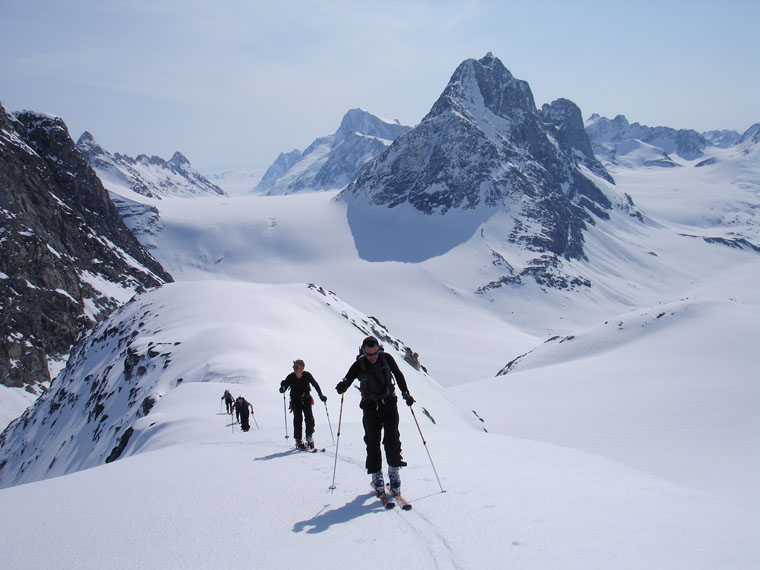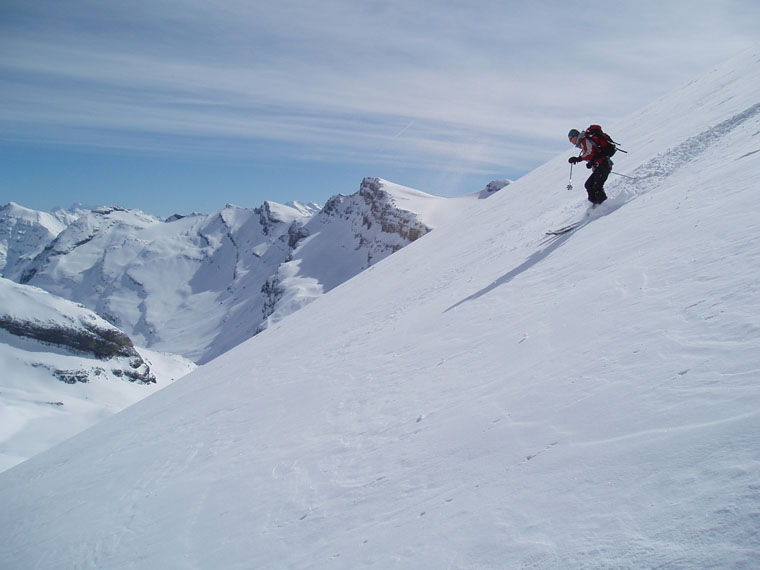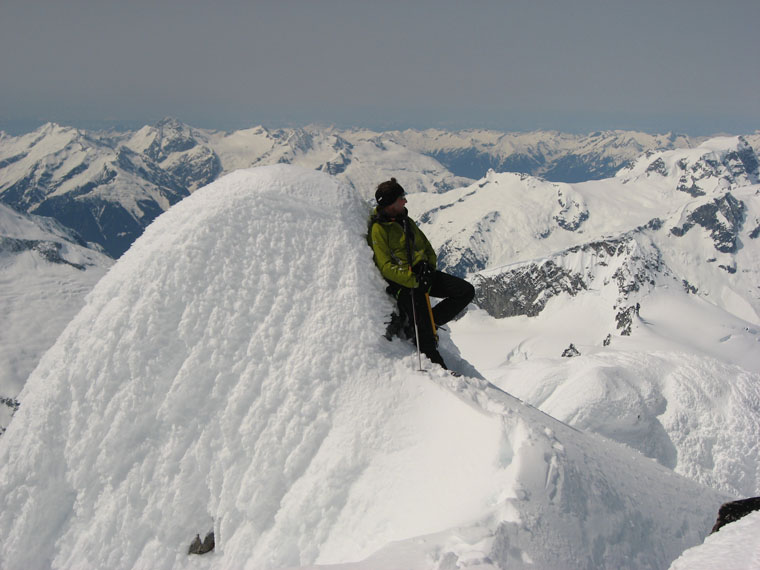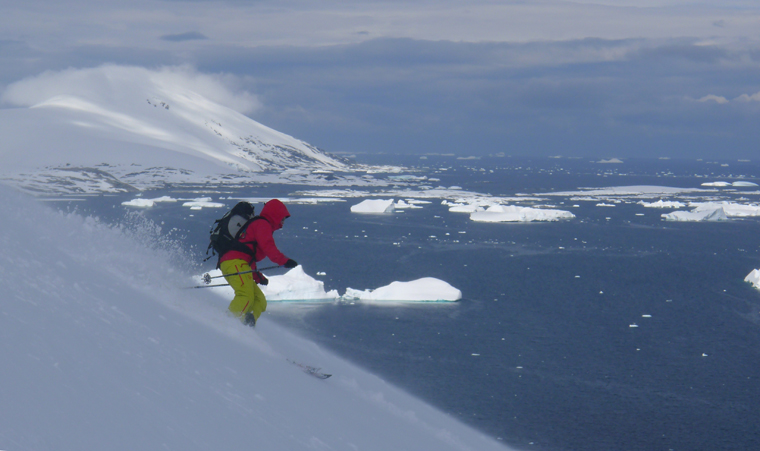A Guide’s Guide to Guides


Mountain Guides (we’re talking real ones, capital G, with the international IFMGA logo) come in all shapes and sizes. Big ones, little ones, fast ones… they might wear the same badge, but they are all special in their own way. In this article we introduce you to the fabulous mix: what to look for, where to find them, and how to choose the ideal Guide and companion for your next adventure.
We’ve all heard the stories of Brits abroad, working in ski resorts and getting carted off by the gendarmes who get the hump with Johnny Foreigner teaching skiing without the pre-requisite paperwork. This
is mostly because some countries have way more ‘protected professions’ than we do over here, and more in the way of bureaucratic work permit systems.
In the UK just about anyone can call themselvesa mountain guide (small g intentional), set up a website and crack on with the job – and many people do it very well. Not so in the Alps.
It’s not uncommon for us to leave the tunnel of the Aiguille Du Midi (perhaps en-route to the Vallée Blanche), tie on to our guests for the arête, and meet a member of the PGHM (the French mountain police) who’s there to check our credentials. What are they looking for? The IFMGA badge, and the distinctive yellow carnet we carry.

Now I’m proud to be a Guide, and I’m reassured by this process. The reason we get a smile and are waved on (where some ski instructors have meta wall of issues and hassle, or even left in the chopper) is that members of the British Mountain Guides are all part of the International Federation. The bottom line is that my carnet (or licence) is not a British document. It comes from the same IFMGA office as a French, Austrian or Swiss Guide’s.
Our profession is one of the oldest in the mountains, and many early ascents relied on local Guides for skills and route-finding (think Whymper on the first ascent of the Matterhorn). As a job, it is an absolute privilege to share and enhance people’s enjoyment of the mountains; to look after our guests through great times and spend so much quality time with such psyched people.
Ask any Guide you ski with to see their badge and carnet: hopefully you’ll find it as reassuring as the French police, and be sure you have someone with you who’s up to the job.
For years, the ski standard of the Brits was fairly weak compared to their continental brethren – but that’s not acceptable any more. When a country first joins the IFMGA (take Peru as a recent example of a country without skiing) there may be a period of time to get their skiing standard up to scratch. But there is no longer any exception made for the upcoming Brit talent.
Aspirant Guides like Ben Tibbetts have serious experience under their belts already. Having skied the Haute Route in a single push, and as a member of the podium-placed GB ski rando team (read all about this next month in FL), he is one talented all-round performer. And new kids on the scheme include Black Crows-sponsored Tom Grant, who has only just begun the long journey to getting the badge, so the future is bright for BMG skiers.
The road to becoming a ski Guide begins with a long mountaineering apprenticeship. Before the formal process even begins, mountaineers have to submit a CV of complex ascents, technical climbs and challenging adventures around the world: climbing grade V ice in Scotland, extreme rock in the UK, numerous summits in the Alps… To give you an idea of the standard, you must submit a list of ten “Grandes Courses”. At 1000 metres of hard climbing or more, each of these climbs must be of the same calibre as the Eiger North Face. Imagine how much climbing you have to do before just one of these is a good idea!

For the skiing application, an extensive list of multi-day hut-to-hut tours is the order of the day. We all have our heroes from this period of our apprenticeship. For me, the likes of Nigel Shepherd (how the hell do you ski breakable crust like that?); Iain Peter (and the crew from those early days in Tignes, who taught us as much about shoe-box business as they did about skiing the steeps safely); and my personal adventure guru, Rob Collister (who was both writing and skiing “Over the Hills and Far Away”). This is frankly still the only place you will ever find him – so don’t Google that one: he’s off skiing somewhere you have never heard of!
All that experience just gets you to the application stage. Once you are out of the starting blocks, there are at least three years of assessments in every discipline, and a couple of seasons working under the wings of experienced Guides. In my case, the Training Officer to mentor me through the scheme was Richard Mansfield, and I still love getting the chance to ski with him.
One of the great things about British ski Guides is they’re usually pretty footloose and skilled at taking their experience to new places; whereas in some countries there may be a culture of local knowledge, and local Guides following in the family trade.
I remember being in a lift in Champoluc with my guests for the day, when a Swiss banker and his private Guide from Zermatt hopped in. The Swiss skier was staggered that here was a Guide from Wales, charging English skiers money. His Guide, on the other hand, broke in to a broad grin and sidled up to me so our badges were side by side. Pointing at these the Swiss Guide (in immaculate English) explained that while I was English, he was Swiss, and we were all in Italy! Further afield, making the first ski descent from the summit of Kalanag in the Indian Himalaya, our clients were not losing out from our lack of local knowledge…
The reality is that you can find all of the British Mountain Guides listed on just one website (www.bmg.org.uk). There are less than 200 members, and only just over 100 of these are actively Guiding. The great thing is that all have had to meet the same rigorous standards to pass their assessments in all aspects of mountaineering.
But this is just the start. One thing they have in common is that they are all unique. While some will specialise in expedition climbing (you may have heard of Kenton Cool perhaps?), others will specialise in rock climbing, Alpine climbing, ice climbing and so on. Even those who specialise in skiing have their own niche and nuance.

So here, in a crazy act of professional suicide (or at least alienation from all those equally awesome ski Guide colleagues who can’t be squeezed in to these pages) are ten Guides who leap off the page as offering something unusual on planks. I hope this gives you some idea of the variety on offer, and helps you clarify what you need to ask the next time you book one. I daren’t even number them, so here they are in random order:
BRUCE GOODLAD is the current Training Officer of the British Mountain Guides, so he gets to oversee the training and assessment of the next generation.
He is also a keen writer, with a great book on Alpine climbing already published and a new book on ski mountaineering in the pipeline. He has a thing about avalanche education and runs the AAIRE courses in the Alps, as well as Guiding on skis.
JIM BLYTH is captain “obscure ski adventure”. If you check out his website you will see a whole year rammed full of fantastic ski adventures to far-flung places. He is one of those annoying people who, whenever you Google somewhere new,has just been there already!
TANIA NOAKES is an ex-forces cross-country skier turned Guide. Tanya races in the GB ski rando team, and they knock out some world-class performances. She is as fit as the proverbial, hard as nails, skis like a demon and will give anyone a run for their money when skinning uphill.
I last recognised her by the joyful giggle that came out of the mist on a filthy day above a hut in Austria. Well, nobody else would have been out there…
NICK PARKS is often known as the Pocket Ski Guide. What he might lack in stature he more than makes up for in energy and enthusiasm.
I was lucky enough to ski with Nick on a busman’s holiday in British Columbia, and he is one of the most inspirational skiers you will ever ski with. He also laughs a lot more than most people on the planet. He is experimenting with staying in one place for most of the winter, and has settled on Zinal (for now). This speaks volumes about the Val D’Anniviers…
JOHN FALKINER is the black sheep in this list as he is really an Aussie Guide. John was made famous for his part in the Blizzard of Aahhs, and is one of the few people who could follow Nick for inspirational value. I remember sitting on the terrace of the Hohsaas hut one afternoon when Jon started reminiscing about the first telemark ski descent of the Marinelli Couloir, as we watched the sun set behind the Macugnaga face. Cripes! Everyone should go skiing with John at least once.
RIC POTTER shares his time between home in Wales, a base in the Alps and ski adventures around the world. Ric is one
of the few Guides who Guides on a split board as well as on skis (there are others,
of course). The fact his daughter is a professional snowboarder tells you all you need to know about Ric’s ability to bring out the best in his team.
AL POWELL is another racing snake who is as at home in Lycra as he is in down. He heads up the talented ski team at Alpine Guides and has competed in the GB ski rando team. They have a great thing going on with Backcountry UK in Ilkley, so they can offer you the full package.
HANNAH BURROWS-SMITH was born into skiing. She shares her time between her new home in Vallorcine and her roots in the Scottish Highlands. Hannah has just published a book by the British Mountain Guides (A Passion for Mountains) so she would be better placed than I to be writing this, to be honest! From off-piste adventures early season to springtime ski summits and safaris, Hannah offers the lot.
RICK MARCHANT’S prowess on skis was first described to me in a legendary tale of skiing the NE slope of the Courtes. While this is relatively tame by modern standards, it was epic at a time when skis were shocking, and Rick’s were worse than most. The story tells of him having a pair of planks so old that one of the skis only had one edge.
Deliberating at the top of the 48º slope, he had to decide if the right or left turns would be most important, in order to choose which foot to wear which ski. This tale is so epic I don’t even care if it’s true! Rick lives in Argentière and Guides on proper planks these days.
ANDY PERKINS is Dr Sling, on accountof his PhD in tying knots (or maybe it was slightly more complex than that). He is also pretty handy on skis. Andy has a passion for exploring obscure winter nooks and crannies of the Alps, as well as posting every snippet on social media. It all bubbles up to a wealth of experience, a fantastic resource of venues and conditions, and an infectious enthusiasm for adventure, which all comes across as tremendous fun!

You can find all of the above Guides, and many more besides, on the BMG website. Just because these folks stand out in some obscure way doesn’t make them any more suitable than all the others.
It just shows the diversity of characters that make up the team. The one thing you can be sure of is that everyone who wears that badge has been through the most rigorous of training and has that little something special about them.
At the end of the day, you are choosing to share your precious holiday time with these people, so look for the sort of folks you’d want to spend time with, as much as anything else. Ski Guides are pretty good at steering you towards the ideal Guide. So if in doubt, just call one of them up and ask what they think. They’re bound to make sure you find what you’re looking for. It is their job, after all.